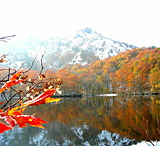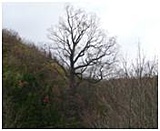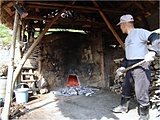Breeding of Tsunogawa
Summary of the Tsunogawa district
Local outline
The Tsunogawa area is located the south of Tozawa-mura, Yamagata (approximately 5,400 population) and is typical farming and mountain village area among the mountains in every direction. It is dotted with 14 villages along "Tsunogawa" and the branch which assume mountain ranges in front of Tsukiyama of the 1000m grade the source, and 285 households, more than 900 live.
The history of the Tsunogawa district
According to Tozawa book of a village's history, Tsunokawa-mura belongs to the Furukuchi volost in the Edo era, the fields 60 chohoyo ri, number of houses 137 houses, a population of 800 people (1812, 1813). For Edago, I counted 32 villages of Numata in a swamp, a shield bottom, 12 swamps, Mitsuya, Akagi, Yamamoto, Nakajima, Sunada, door front, *etsu, Hatamura, truth ka Kizawa, Tashiro, Tsunatori, Motoyashiki, evil door, Nagakura, *gookushiki, Katakura, flat root, scenic spot, Takabata, top field, Iwaki, Iwano, swamp of a bottom, the deer of Nakazawa, Arayashiki, Inamura, a hill, the waterfall. The main industry of this time was agriculture, and charcoal making, hunting, sericulture was carried out.
In 1953, the government established merger promotion law, and I received this, and Yamagata settled a guideline more than a population of 8,000 people on the appropriate scale of municipalities. It is time, April 1, 1955 of "the great merger of the Showa" that current Tozawa-mura was born. The population at the time put approximately 2,600 Tsunogawa, approximately 3,800 Furukuchi, approximately 5,000 old Tozawa together and went over 10,000.
Natural beauty spot, historic site
◆Mountain worship and now Kumano Shrine, tsukisantohaido
As for the Kumano faith of the triumvirate mixture of Buddhism and Shintoism to worship the open Amitabha, The Buddha of Healing, Goddess of Mercy in Kii Kumano Mountains, it was done kansei in the whole country by incarnation of the Amitabha and done Kumano honorific title of a Japanese god, and, as a result, Kumano Shinto shrine was built in each place. It was not sure, but Kumano Shinto shrine seemed to be just erected in 724 (Jinki 1) by Kumano mountaineering ascetics when and what kind of figure it was spread in the Kadokawa district with (I guess it from imakumayadaikengenenryakuki). As a line place of these mountaineering ascetics, waterfall of Mt. Kuma-yama, enforcement stand (stand of the cedar), *, tohaido which, besides, continued to Dewa Sanzan were just made.
The gods and Buddha are united with each, and, in Tsukiyama, as for god of night and Amitabha, Haguroyama of younger brother God of the Sun-Goddess, in wave God, storehouse flash of lightning life and Goddess of Mercy, Mount Yudono, large mountain god life, large serpent command, shohikomeimei and Dainichi Buddha are worshiped in Italy. The starting point to these Imperial mausoleums was called eight shares of Tsukiyama every quarters and was Tsunogawa mouth with Hijiori Exit (Okura-mura), right way Teraguchi (Nishikawa-machi), Oi Sawaguchi (Nishikawa-machi), Iwane Sawaguchi (Nishikawa-machi), greater omentum mouth and Seven-Five-Three Festival basis of living (former Asahi-mura), wild Sawaguchi (former Haguro-cho).
A mention about the Tsunogawa Exit is hardly done by the documents. Haguro was the mountaineering asceticism ground that prospered in the whole country from the old days of the bee child prince, but Kadokawa came to boast of power not to be inferior to Haguro as a large dojo studio of 48 Bo (36,304 number of Miyama Buddhist ascetics of 1709, 1709), and the fetters of the Tsunogawa mouth route were cut off for the starting point of a mountain climb fight by Haguro mountain side, and, as for this, might a way be snowbound? It seems that this may be because there is one paragraph called this.
In closed tsukisantohaido, a way was opened again for a long time in the life (1994) of the Heisei
◆Waterfall of *
A waterfall of way sugaraniaru 80m in height of tsukisantohaido. As for 150m in height of the columnar joint, the rock face which there will be rises on both sides. I am in full glory so that appointed Lilium rubellum clings to the flower of the village in bave rock (the beginning of June in full bloom). As for the past, mountaineering ascetics are * memashita with the body at this waterfall. I arrive on foot from the terminal of the road for the construction in more than 30 minutes.
◆Oike
Is in the depths of Imagami Onsen, and is foot from the hot spring; 30 minutes. 400m above sea level, neighborhood 630m is a crater lake of maximum depth of the water 7m. In the year of the drought, the quantity of the water maintains the same at the time of heavy rain again so much, and there is no increase and decrease. I could believe it when I finished a dragon King here in an abode of wizards surrounded by the rocky mountains where Mikata was steep and came to praying for rain from far-off villages in the year of the drought. When I stain Oike and ride a ship, this dragon King begins to be angry and is afraid when I bring a heavy rain as it carries away the village of the foot.
In addition, precious animals including harpoon green frog and the Ruri damselfly inhabit Oike, and the outskirts are saved with the deciduous broad-leaved forest mainly involving the beech being near abiogenesis. The Kamiyama whole area is performed designation (1975) of now in the special sanctuary, natural environments maintenance area.
It is called "Osugi of Tsunogawa" in the huge tree of the cedar in the precincts of Kumano Shrine now. I reach trunk circumference approximately 9.72m, 42m in height. It is thought that I met after the Shinto shrine foundation together, and the age of a tree is over 1200 and is worshiped as a sacred tree to local people. It became the natural monument of the Yamagata designation in 1952.
◆Co-Japanese oak of the flat root
In the Mogami area where a huge tree is discovered in succession, "the coJapanese oak of the flat root" enters the whole country ranking alone in our district (the second place), and the trunk circumference amounts to 6.05m. I do not become known whether a huge tree is covered to Kadokawa having very large Yamaji still more either.
Living, culture
◆The prosperity of the charcoal making
It shows the high fame and popularity of the Tsunogawa charcoal other than championship at the competitive show of the prefecture to win the championship nationwide. Other local suppliers demanded it by name in the golden age, and even the same class was traded at a high price from other production centers.
The charcoal making of the Tsunogawa district was carried out for Edo period. However, it was for self-support at that time or was small scale of the degree depending on the demand of not more than neighborhood. As for charcoal production having presented an active state in our district, there is the station of the railroad in Furukuchi, in the Taisho era after the Rikuu West Line opening (1913) from the middle part was, and, in 1923 when the charcoal to produce most became popular, as for the volume of shipment, 125 charcoal kilns existed 370,000 presence really. The row of sleds when I shipped it from Tsunogawa to the warehouse of Furukuchi Station in terminal winter in the Taisho era seemed to be the admirability that 3km continued. The charcoal which prepared it was this local important industry, and the high fame and popularity did not change for a while after the war. hanegami*kichishi (Katakura) wins championship at the national competitive show of 1950 and shows our local technical height. The charcoal kiln which I made at Country experience private supplementary school tsunokawano village operates now.
◆Village of matagi
The hunting culture of the Tsunogawa district is prosperous in the times of Meiji, the Taisho era and is counted in one of the main occupation of Tsunokawa-mura in "zo*itojogunshi". Furthermore, including "a knotweed" and a matchlock used for hunting bears, it shows that the hunting of our district was prosperous that various hunting tools are left. A member of hunting club went down approximately 150 at the mid-50s of the Showa era and seemed to be most districts in Mogami-gun.
When the hunter enters the mountain, I avoid words using every day in a village and use the unique words (language used among hunters and charcoal makers). It is thought that I am caused by strictness of the work that this violates danger in mountains and chases game. Severe thing prohibition depending on this was necessary, and taboo easy lateral mourning peculiar to a hunter here, faith, matagi document was born to have you give rich game from a god of the mountain. Most of the language used among hunters and charcoal makers is not employed now, and the person hunting becomes 10 several.
[example] Gun - through be, dying ... sashitotta, rabbit - sugane, dog - seta
Snowshoe - hakiase spread; ... sattei, fried rice - Ann mon
Total leader when I hunt in deer re-... group





